How to Make Money on Instagram
If you click to purchase a product or service based on our independent recommendations and impartial reviews, we may receive a commission. Learn more
The Keys to Making Money and Building Brands on Instagram
Instagram is one of the world’s biggest social media platforms. It is also, increasingly, one of the most lucrative for businesses of all sizes, and even you can make money on social media through it!
Millions of businesses use Instagram to connect with the platform’s billion plus users, combining ads, in-app shopping features, and influencer marketing to boost sales and strengthen their brand. Instagram may even add Shopping to its main navigation soon – a huge statement of intent about where the app is heading.
It’s perfectly reasonable to want to be part of that. It’s also perfectly normal to be a little daunted by it all. This article is here to break down the steps, from setting up your online store to Instagram post strategy (yes, that’s a thing).
Selling on Instagram: Step-by-step
- Create an Online Store
- Set Up an Instagram Business Account
- Link Your Online Store
- Create Shoppable Posts
- Create Stories with Product Links
- Use Instagram Shopping
- Use Instagram Ads
- Partner with influencers
- Get Your Posts Noticed
- Analyze Your Performance and Test
Not everyone starts at the same point, so have a gander at the steps below and step in wherever suits you best.
1 Create an Online Store
First things first. If you want to sell on Instagram, you need an online store where you, well, sell things. It’s worth being clear here that Instagram is not a shop, so much as it is a shop window – a place to showcase your products and grab the attention of potential customers.
Platforms like Wix, Squarespace, and Square are especially good for small stores, while the likes of Shopify and BigCommerce are good for larger operations. All of these allow you to connect to Instagram and sell there. Whichever ecommerce platform you choose, be sure they offer the same connectivity.
Don’t breeze over this step. The more thorough you are here, the easier everything else will be. Clear, organized, descriptive product listings are the foundation of selling online. Getting that right allows you to focus on Instagram and other marketing channels.
Speaking of which…
2 Set Up an Instagram Business Account
Congratulations – you have an online store! Now you need an Instagram business account to connect it to. This is how you’re able to send users to your products.
This is super straightforward (and free). Simply…
- Go to your profile
- Tap the burger bar
- Tap Settings
- Tap Account
- Tap Switch to Professional Account
- Tap Business
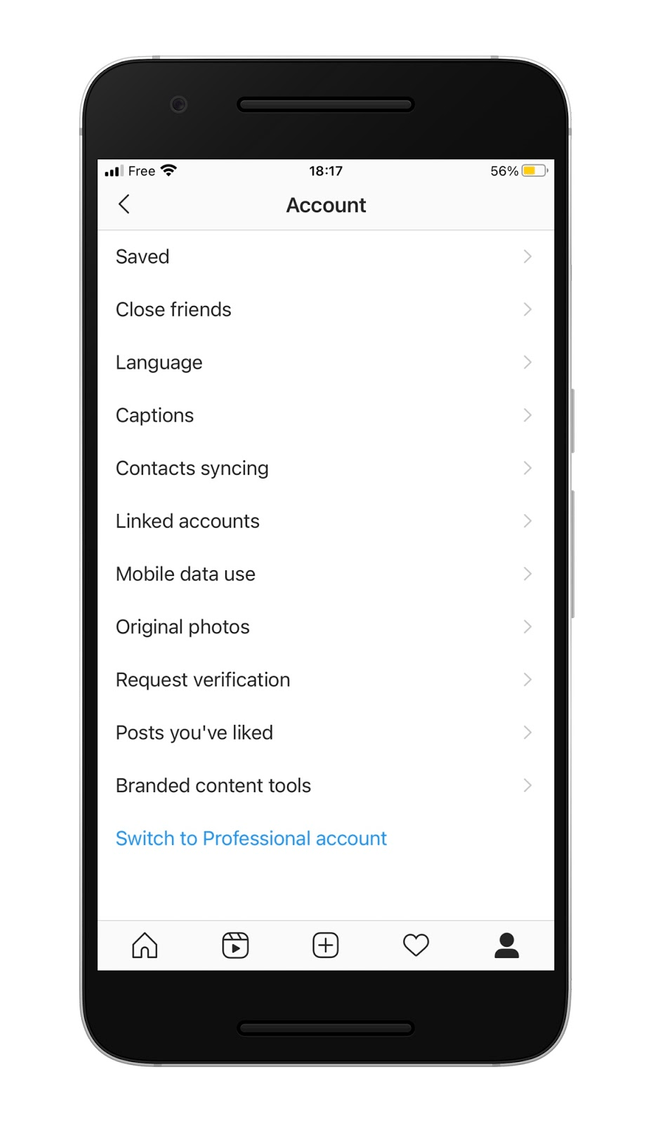
And that’s it. You’ll also be invited to connect the Instagram account with your business’s Facebook profile, if it has one.
3 Link Your Online Store
Once you have an online store and an Instagram business account, all that remains is to link them. Then you can start selling.
In early 2020, Instagram Shopping moved under the umbrella of the newly launched Facebook Shops. To connect online stores to Instagram, you’ll need a Facebook Shops account. Once that’s up and running, you’re ready to connect.
How to do this varies a little depending on the builder you’ve used for your online store. Below are step-by-step guides for the big five – Wix, Squarespace, Square, Shopify, and BigCommerce. All five are designed to integrate with Instagram.
Provided your products abide by Facebook Commerce Policies, this should be a formality.
Wix
Wix prides itself on ease of use, and its Instagram integration seems to be no exception.
You can connect your shop directly from the dashboard. Start there, then:
- Select the Sales channels tab
- Select Instagram from the drop-down menu
- Select Start Now
- Select Connect Instagram Profile
- Select Connect Account
If you’re not already linked to Instagram, you’ll then be prompted to sign in. After that, you’re good to go. Sign in to Instagram, and make sure everything’s in order.
Wix has a page it updates whenever new features are added – very handy for staying up to date on the latest possibilities.
Squarespace
Connecting to Instagram Shopping is a feature available in Squarespace’s Commerce Basic and Advanced plans.
Once you have a stocked and operational store, go to your business’s Facebook page and create a new catalogue. You’ll be given the option to connect to a pre-existing e-commerce store. Once you’ve input your details, it can take several days to approve, but once it is, everything’s ready to go.
Provided your Facebook and Instagram business accounts are linked (which they should be), the catalogue will be automatically accessible.
Square
As with the others, connecting your Square inventory to Instagram involves only a few steps, provided basic requirements are met. You’ll need a functional, live online store, and all the appropriate accounts (i.e. Facebook and Instagram).
If those boxes are ticked, go to your Online Store Dashboard, then:
- Select Website
- Select Instagram
- Select Set up and follow on-screen instructions
- Choose the Facebook account you wish to connect to
- Approve Connect
Mostly it’s that simple, though depending on what Facebook extensions you have, there may be a few more steps. If anything stumps you, Square’s documentation really gets into the weeds.
Shopify
The steps for Shopify have been a little changeable lately, due to Instagram Shopping being absorbed into the Facebook monolith. We do our best to keep guides up to date, but if anything seems iffy, check Shopify’s latest documentation.
- From Shopify admin, go to Facebook sales channel, then Overview
- Select Set up to start in the Instagram Shopping section
- Connect the necessary Facebook accounts to the Facebook sales channel
- Read the terms and conditions, then select Request approval
It usually takes Facebook 24-48 hours to review your products and approve the connection. Once they do, you can go to your Instagram settings and confirm the product catalogue.
BigCommerce
In the spirit of their name, BigCommerce’s documentation on connecting to Instagram and selling there is, well, big. Well worth a read.
Setup is a small part of that. There are a few more steps, but that’s because e-commerce is BigCommerce’s bread and butter.
- Go to Channel Manager, then Facebook, then Connect
- Select the Facebook account(s) you want to connect to
- Enter shop details, including business address and tax information
- Choose shipping options for orders made through Instagram
- Set up your return policy
- Select Accept Terms
- Select Setup Payments
- Select your Default Category, i.e. the type of products you sell
- Select Export to submit your catalogue to Facebook
How long approval takes is at the discretion of Facebook. Sometimes it takes a day, other times it takes several.
The extra steps here are a testament to BigCommerce’s frankly peerless thoroughness where ecommerce is concerned. Getting in-depth logistics out of the way allows you to focus on the more creative business of Instagram marketing.
4 Create Shoppable Posts
Shoppable posts have made waves since being added to the platform in 2018. They allow you to tag products in your posts, much like you’d tag people. If users are interested in learning more about a product, they can simply tap on it for more details.
This feature lends itself particularly well to visual sectors – fashion, interior design, things like that. Posts can showcase your brand while guiding users to your products.
IKEA, for example, is able to share posts that serve as sources of inspiration and as a kind of shop floor.
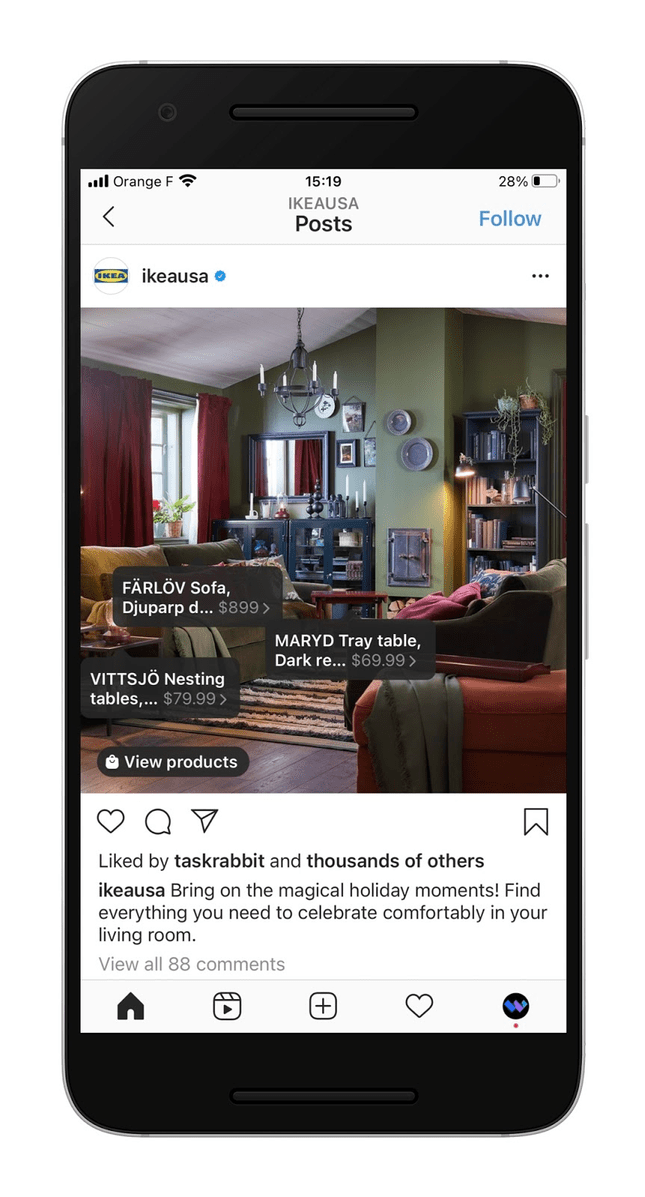
As for how to create Shoppable Posts, it’s much the same as regular posts. You’re just tagging products rather than people. Bear in mind, however, that you can’t currently tag both products and people in one post. It’s useful to see them as belonging to different types.
This, incidentally, is a big reason why getting your online shop in order is so important. Instagram is a vibrant, visual medium, but when people click through on products they like the look of, they need to be met with good information.
5 Create Stories With Product Links
Engagement with Instagram stories is crazy high, and only going up. Stories provide a more intimate space to interact with your followers. Because they expire, they also have a sense of urgency that posts don’t.
These are great for seeing products ‘in action’, or simply having some fun on the fly. If you’ve connected to your online store, then your products should appear as sticker options when preparing a story.
6 Use Instagram Shops
Instagram is leaning pretty hard into ecommerce. Nothing shows that better than Instagram Shops, which allows you to set up dedicated storefronts separate from your image feed.
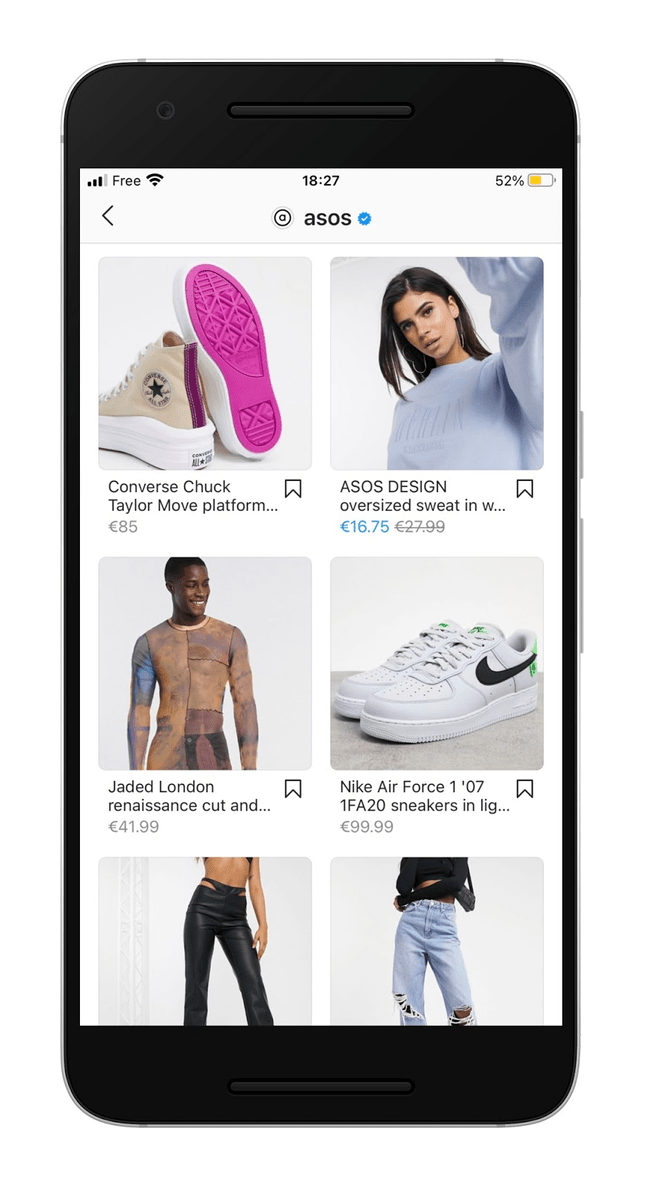
This feature has been motoring along since launching in May of 2020. It came largely in response to the strains of the COVID pandemic, with in-person shopping not always possible. More checkout options are being rolled out by the week, with platforms like Shopify and BigCommerce stepping up their integration in turn.
Instagram Shops are a place for followers to browse your products, and a nice dose of simplicity for sellers and shoppers alike. Digital marketing can be too clever by half at times.
7 Use Instagram Ads
Yes, among all the intrigue of feed strategy and tagging and user generated content, there is still a place for good old fashioned advertising.
Ads on Instagram follow the same formats as regular content, which is to say they can be:
- Photos
- Stories
- Videos
- Carousels
- Collections
The main benefit of ads is reach. You’re getting your brand in front of people who likely haven’t seen it before. While not the be all and end all, they’re an important part of Instagram strategy.
As a rule of thumb, it’s best to get your house in order before throwing money into advertising. The more comfortable you are with your tone, content, and target demographics, the easier it will be to point your ads to relevant audiences. For information on how much it costs to advertise on Instagram, check out our dedicated guide on this topic.
Instagram has a full breakdown of their ad services that’s worth a read before you really get stuck in.
8 Partner With Influencers
It’d be remiss of us to talk about selling on Instagram without dedicating time to influencers. For those not in the know, ‘influencers’ are popular accounts that feature products in their feed. Love them or hate them, they are a major part of the playing field.
This requires more thought than just approaching popular accounts and paying them to feature your products. Influencers ride a fine line between warm, relatable personalities and ice cold advertising mannequins. It’s product placement in people’s online lives, essentially, so the partnership needs to be appropriate.
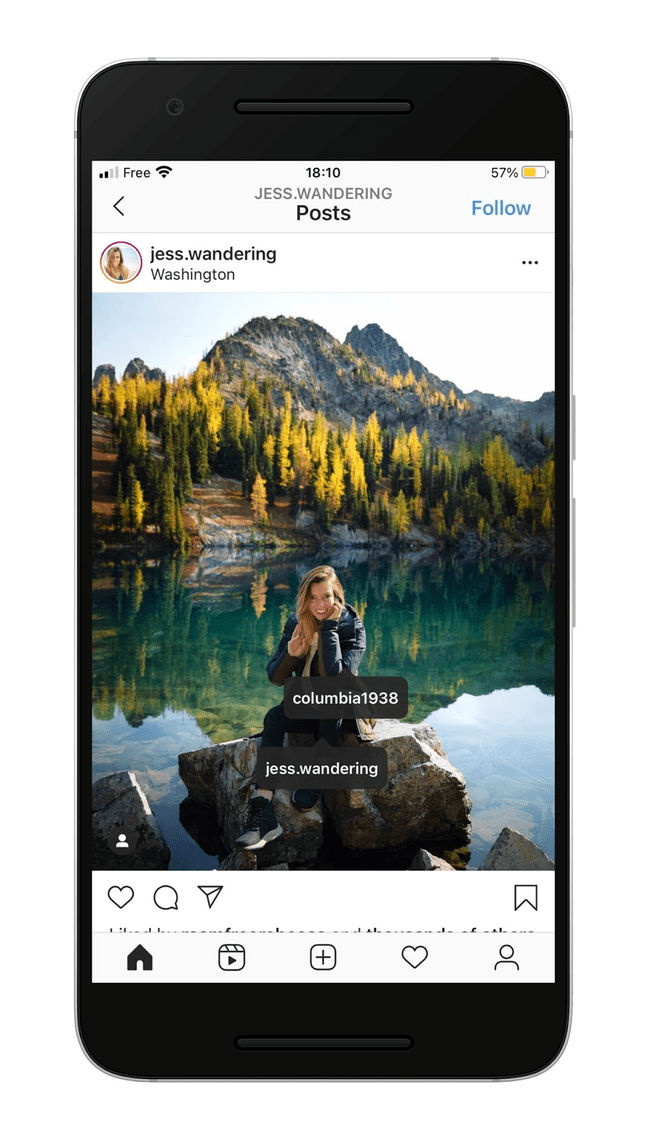
Go into this with your eyes open. This is the only step outside of Instagram’s built-in features. It’s a potentially brilliant marketing option, but there are also a lot of pretenders. Tread carefully.
9 Get Your Posts Noticed
We hate to be the bearer of bad news, but using Instagram’s Shopping features won’t magically bring in waves of new customers. You have to do it right.
With billions of posts each day, there’s a lot of competition. Your posts need to stand out. Below are several ways to give yourself the best chance possible of doing just that.
Be Consistent
There’s no sense in pretending to be something you’re not. Like all social media channels, Instagram should be a natural extension of your brand. That means tone, values, language, and visuals.
We’ve spoken already about how top brands weave shopping into their Instagram profiles in a way that feels natural and appropriate. They feel that way because it is natural and appropriate. Understand your brand, believe in it, and everything that follows will be much, much easier.
Use Images
There’s a lot more to selling on Instagram than posting pictures or products in front of white backgrounds. In fact, that’s usually something to avoid.
Product listings are fine for Instagram Shop, but the main feed needs to have more character. Your feed needs to be worth following even if you weren’t selling stuff.
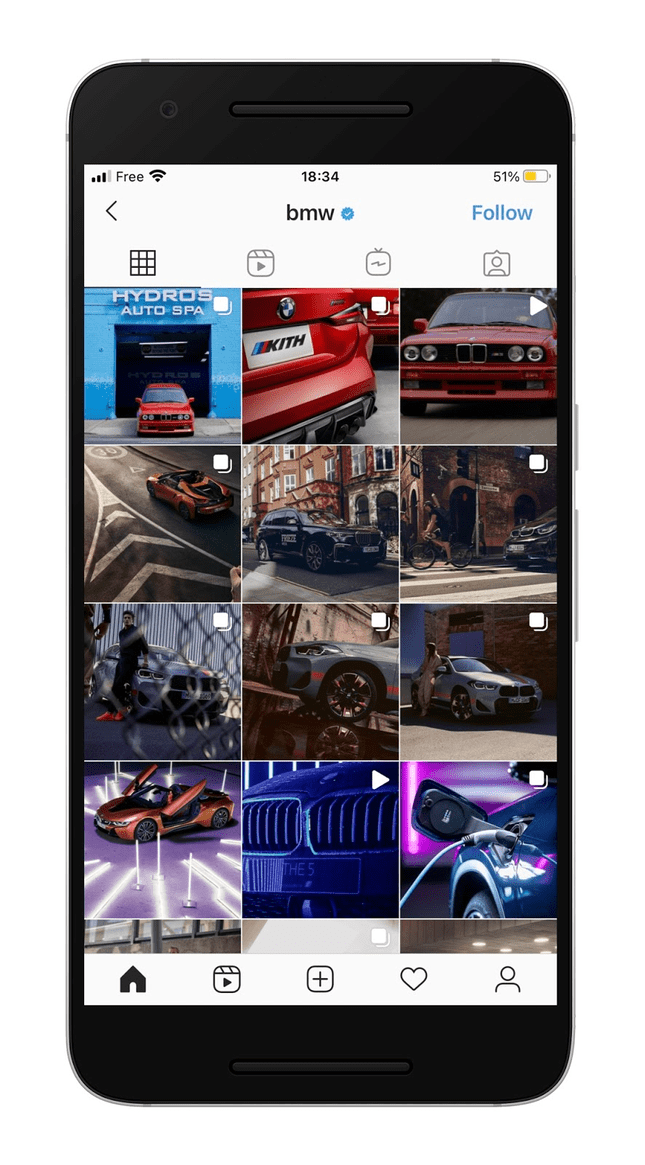
What exactly that means in terms of images depends on your sector, your products, and your brand. Sadly, we can’t plan that for you. Again, know your brand, then examine accounts you admire and emulate them. All great art is copied, as they say. As you find your feet, your Instagram identity will find its own form.
Use User Generated Content
One of the best things about Instagram, and why it’s such a great place to sell, is that it’s a place to see products ‘in action.’
If there are people using your products and tagging you in their posts, then reshare, reshare, reshare. Here are just a few reasons why user generated content is brilliant for Instagram marketing:
- It’s genuine
- It’s social proof of people enjoying your products (pro tip: Don’t reshare posts complaining about them)
- Offers the chance to interact with existing customers
- They’re more trusted than ‘professional’ looking posts
Let’s not kid ourselves that Instagram is real life – it’s not. User generated content is a lovely dose of reality. If people are genuinely using and enjoying your products, that’s something to celebrate and share.
Ask for permission, credit (and thank) the original account in the caption, and voila – top rate marketing material. You didn’t even need to leave your chair.
Write Descriptive Captions
Instagram is such a visual place that it’s easy to overlook the value of powerful writing. There’s an unfortunate instinct to shy away from anything longer than a few words. Short and snappy can be great, but so can long and absorbing.
Take FedEx, for example. Not an obvious fit for a platform like Instagram, but by leaning into the romance of mail, they’ve carved out a strong presence.
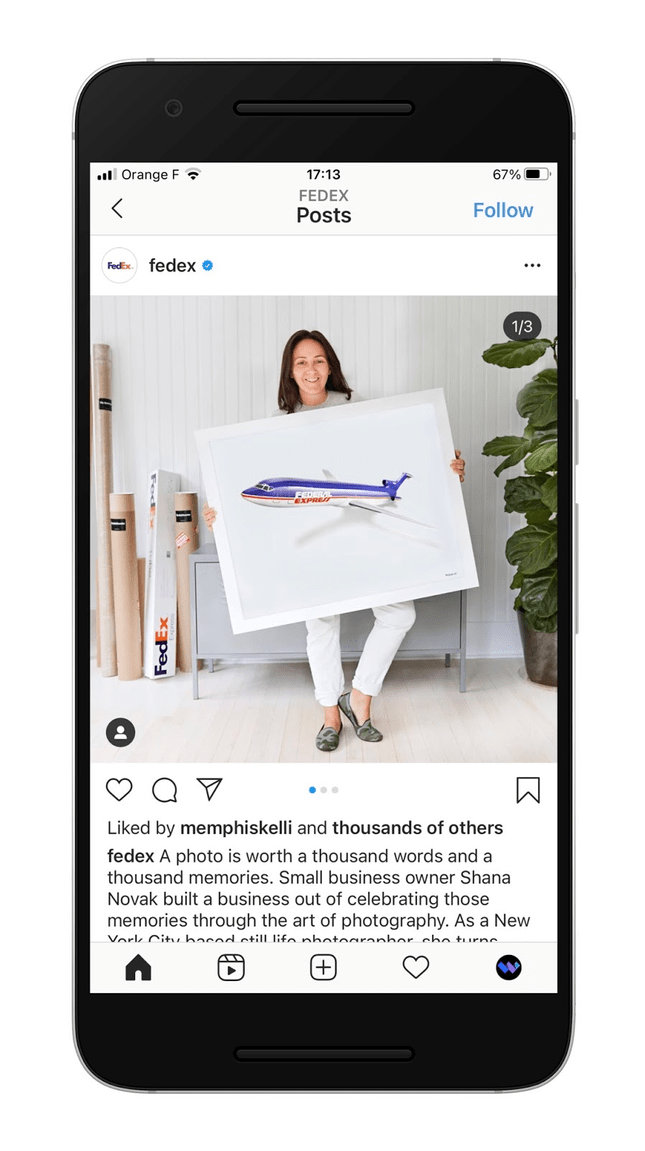
Don’t be afraid of telling a good story. Indeed, what a shame if you had a good one and kept it to yourself! Jack Daniel’s ‘Postcards from Lynchburg’ is the longest running ad campaign in history, and boy are they wordy.

It’s a judgement call, ultimately. Short captions are fine, but don’t be afraid of long ones when it’d be more appropriate. Whether it’s a poster or an Instagram post, sometimes only a story will do.
Conduct hashtag research
Using hashtags may seem a bit old school these days, but they’re still a terrific way of finding new eyeballs for your brand. (Figuratively. Figuratively finding new eyeballs.)
Come at this two ways.
First, look at what accounts similar to yours are doing. What tags do they use? Try them yourself – have pools of tags to draw from for different types of posts.
Second, track how tags are performing in Instagram analytics. It shows you exactly how much attention different posts got through different tags. Over time, you’ll get a clear sense of where your brand thrives, where it doesn’t, and where it just might in the future.
Tagging isn’t the sexiest part of selling on Instagram, but ignore it at your peril. Done well, it’s a great way of finding new potential followers and customers.
10 Analyze Your Performance and Test
It’s easy to feel overwhelmed by all this, or feel like you’re lagging behind the competition. First off, don’t worry – almost all of us feel that way from time to time. Second, you needn’t keep yourself in the dark. Track your performance to find opportunities to evolve your approach.
Instagram offers very useful analytics about your users – for free! Use them, see what posts are working best, and find patterns to work out why.
And don’t be afraid to throw in the odd curveball. It’s not uncommon for analytics to become the tail that wags the dog. Believe in your brand and show a bit of personality.
How to Sell on Instagram: Recap
Selling on Instagram is easy. Making money on Instagram takes planning, organization, and a good dose of flair. In the spirit of a good recap, here are our recommended steps at a glance:
- Create an Online Store: Success selling through social media starts with having a well stocked, well organized digital store
- Set Up an Instagram Business Account: Unlock new selling and analytics features (for free) by turning your Instagram profile into a business account
- Link Your Online Store: Connect your online store to your Instagram account to gain access to your product inventory
- Create Shoppable Posts: Include your products in beautiful, engaging posts, then tag them, allowing users to click through to your online store
- Create Stories with Product Links: Interact with your followers and add some urgency to product availability
- Use Instagram Shopping: Set up a dedicated online shop right on your Instagram profile
- Use Instagram Ads: Find new audiences by boosting posts and targeting appropriate demographics
- Get Your Posts Noticed: Share vivid, brand appropriate imagery that would be worth following even if you weren’t selling stuff
- Partner with influencers: Get your products featured on appropriate, trusted influencer accounts
- Analyze Your Performance and Test: Track your progress, never stop learning, and evolving your Instagram strategy. And have fun!
Laying strong foundations is essential. Choose an ecommerce builder with seamless Instagram integration. Wix, Squarespace, and Square have proven track records for smaller businesses, while Shopify and BigCommerce lend themselves better to larger scale retailing.
Whoever you choose, be meticulous with your product listings, and have a solid sense of what your brand is and how you want it to behave. Get those things right, and everything that follows is infinitely easier.
The nuts and bolts of selling on Instagram are simple. Share interesting, brand-appropriate content, tag your products, and get them in front of potential customers as best you can.
And relax. Instagram is oddly real in its unrealness. There’s no shame in evolving – express yourself, interact, track what works, and adjust accordingly. Do that much, and your products will find the audience they deserve.
Happy selling.
More information
- Get more out of Instagram by creating an aesthetic author bio
- Find out how you can use reels for your business.





9 comments